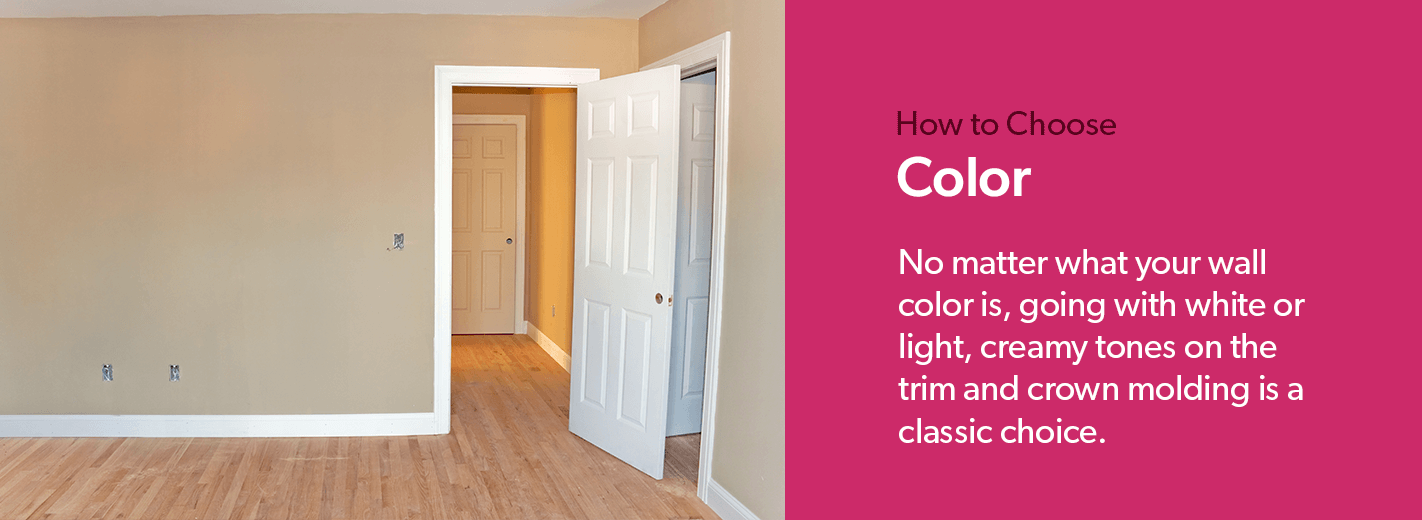When you think of painting a room, it’s often just the walls that get the star treatment, but it’s important to consider the trim and crown molding, too. These gorgeous architectural features shape our spaces, giving style, depth and refinement to a room. Painting these features can subtly add to the color scheme of a room, highlighting your wall colors and other decor and adding to the overall ambiance of the space.
But painting your trim and crown molding is different than wall painting and comes with its own set of tips and tricks. We’ve collected everything you should know about painting trim and crown molding — and the best tip we can offer is to hire a professional to do the job right. Read on for more information on trim and crown molding painting.
Why Should You Paint Your Trim and Crown Molding?
The trim and crown molding of your interior spaces are meant to add visual appeal to any room and draw attention to any architectural highlights of the space. With the right colors and finishes, trim and crown molding can really shine, adding to your overall decor and color scheme. Trim and crown molding that’s well taken care of can even make ceilings appear taller or rooms larger than they are.
If you’re ready to paint your interior walls, it can be a good idea to include the trim and crown molding, too, for a fresh overhaul of the room. Or perhaps your trim simply needs its own refreshing with updated colors or fresh paint. Painting trim and crown molding can breathe new life into your space.
How to Choose Trim and Crown Molding Color
The first step in painting any trim or crown molding is deciding what colors to paint it. If you want to know what color will work, check out these ideas:
- Same color as walls: Painting the trim the same color as your walls gives a very cohesive and modern appearance. For an added layer of sophistication, go with a tinted version on the trim of your wall color. This will keep it in the same color family but give your walls more visual interest.
- Lighter than walls: No matter what your wall color is, going with white or light, creamy tones on the trim and crown molding is a classic choice. This look is clean and crisp and can really accentuate your other decor colors.
- Darker than walls: Another option for your trim colors is to go darker than your wall colors. Dark trim and crown molding is inspired by the old-fashioned look of dark varnished wood trim in older homes. Using black, dark brown or another darker color can give depth to a room and frame the space effectively.
No matter what you choose, just be sure to stay in the same color family so that your colors coordinate. Also take a look at the undertones in the other paint colors in the room. Stick with all warm or all cool colors for the best effect.

Tips for Painting Crown Molding and Trim
When you’re ready to paint crown molding and trim, there are a few more things you should know before getting started. For best results, follow these tips for painting crown molding:
- Use the right tools: The best paint brush for crown molding is an angled sash brush, so be sure to have one on hand if you plan on painting trim and crown molding yourself. These brushes are designed for detail work and are perfect for trim and crown molding jobs.
- Prep the surface: Don’t neglect to do the proper prep work before painting. This can include cleaning the trim as well as any necessary repairs. This will help your paint job last longer and look more professional. It’s also generally suggested that you use primer before painting.
- Use the right paint: As for what kind of paint for trim is best, semi-gloss and high-gloss are durable options that can make these features easier to clean. Paint with a bit of shine is particularly useful for trim around doors and windows, which can see a bit more traffic. This shine also ensures your trim stands out from the rest of the wall. You may even be able to find varieties of paint specially designed for trim work.
How to Paint Your Trim and Crown Molding
If you want to know how to paint crown molding and how to paint trim yourself, these are the steps to follow:
- Choose your paint colors and type: Use the tips above to find the right paint for the job. The color you choose can depend on the room and the style of the house, as well as your personal preferences.
- Gather your painting equipment: Choose the right brushes for trim work — high-quality angled brushes are best. You should also have on hand additional painting supplies like painting trays, painter’s tape, drop cloths and a quality ladder or step stool.
- Prep the surfaces: Preparation work can make all the difference. Your prep work should begin with a good cleaning. Vacuum all surfaces with a brush attachment, then wipe everything with an all-purpose cleaner and soft cloth. Use a more abrasive cleaner and scrub sponge for any tough spots or stains. Fix any damaged spots with wood filler and sand the trim to ensure a smooth surface. Protect furniture and other surfaces in the room with drop cloths.
- Tape off walls and ceilings: While it’s recommended to paint the trim first then your walls or ceilings, you may just be refreshing crown molding and other features. If that’s the case, you might want to tape off walls, ceilings, doors, windows and other areas around the trim.
- Prime and paint: It’s a good idea to start with a coat of primer, let it dry, then coat with your desired color of paint. Use a small, angled brush and work slowly to ensure a careful coating without dripping. Two coats of paint are likely necessary.
- Clean Up: After your painting work is complete, you will need to do some cleanup work. Wash all paint brushes properly, as well as any other equipment used, like rollers or trays. Remove painter’s tape and touch up any spots that need fixing.
Hire Rent Painters for Your Trim and Crown Molding Painting
Painting trim and crown molding can take a lot of work and preparation. By far, the best way to paint crown molding and trim is to hire a professional. Whether you need your whole room painted — walls, trim and all, or just need a refresh on your trim and crown molding, Rent Painters is the answer. Our team of professionals can help you from start to finish — all you need to do is select the colors and provide the paint. We provide everything else.
Contact us today to get started. Our team is here to answer all your questions and get your painting appointment set up.


